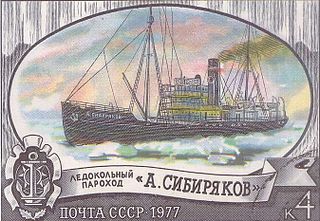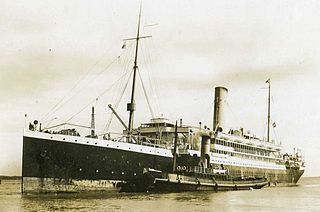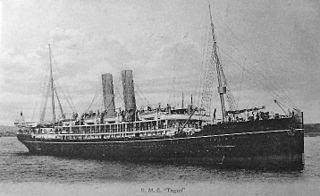
RMS Arlanza was a 14,622 GRT ocean liner of the Royal Mail Steam Packet Company. She was built in Belfast in 1912 for RMSP's scheduled route between England and South America. She was a Royal Navy armed merchant cruiser from 1915 until 1920. She returned to civilian liner service in 1920 and was scrapped in 1938.

Alcantara was a Royal Mail Lines ocean liner that was built in Belfast in 1926. She served in the Second World War first as an armed merchant cruiser and then a troop ship. She returned to civilian service in 1948 and was scrapped in 1958.

RMS Rhone was a UK Royal Mail Ship owned by the Royal Mail Steam Packet Company (RMSP). She was wrecked off the coast of Salt Island in the British Virgin Islands on 29 October 1867 in a hurricane, killing 123 people. She is now a popular Caribbean wreck dive site.

RMS Amazon was a wooden three-masted barque, paddle steamer and Royal Mail Ship. She was the first of 5 sister ships commissioned by the Royal Mail Steam Packet Company to serve RMSP's routes between Southampton and the Caribbean.
SS Chenab was a steamship that was built in England in 1911 and scrapped in Scotland in 1953. For nearly two decades she was part of Nourse Line, which carried Girmityas from India to colonies in the Caribbean and the Pacific. In 1914 she was requisitioned for service in the First World War.

The Royal Mail Steam Packet Company was a British shipping company founded in London in 1839 by a Scot, James MacQueen. The line's motto was Per Mare Ubique. After a troubled start, it became the largest shipping group in the world in 1927 when it took over the White Star Line. The company was liquidated and its assets taken over by the newly formed Royal Mail Lines in 1932 after financial trouble and scandal; over the years RML declined to no more than the name of a service run by former rival Hamburg Süd.

Alexander Sibiryakov was a steamship that was built in Scotland in 1909 as Bellaventure, and was originally a seal hunting ship in Newfoundland. In 1917 the Russian government bought her to be an icebreaker. She served the RSFSR and Soviet Union until 1942, when she was sunk by enemy action. The ship gave notable service in the Russian Arctic during the 1930s.

RMS Atrato was a UK steamship that was built in 1888 as a Royal Mail Ship and ocean liner for the Royal Mail Steam Packet Company. In 1912 she was sold and became the cruise ship The Viking. Late in 1914 she was requisitioned and converted into the armed merchant cruiser HMS Viknor. She sank in 1915 with all hands, a total of 295 Royal Navy officers and men.

RMS Atrato was a UK iron-hulled steamship. She was built in 1853 for the Royal Mail Steam Packet Company as a side-wheel paddle steamer, and at the time of her launch was the world's largest passenger ship. In 1870 RMSP traded Atrato in, causing her to lose the status of "Royal Mail Ship". She was converted to a single screw ship with a compound steam engine in 1872, and placed on the Aberdeen Line that chartered her to run to Victoria and New Zealand. In 1880 she was renamed Rochester before sinking four years later in 1884 by running aground.

Calgaric was a steam ocean liner that was completed in 1917, assumes service in 1918 and scrapped in 1934. She was built for the Pacific SN Co Line as Orca. In 1923 she was transferred to the Royal Mail Line. In 1927 she was transferred to White Star Line and renamed Calgaric.

HMT Aragon, originally RMS Aragon, was a 9,588 GRT transatlantic Royal Mail Ship that served as a troop ship in the First World War. She was built in Belfast, Ireland in 1905 and was the first of the Royal Mail Steam Packet Company's fleet of "A-liners" that worked regular routes between Southampton and South American ports including Buenos Aires.

SS Themistocles was a UK steam ocean liner and refrigerated cargo ship. She was launched in 1910 in Ireland and scrapped in 1947 in Scotland. She was built for Aberdeen Line, White Star Line managed her for a few years, and she spent the latter part of her career with Shaw, Savill & Albion Line.

RMS Asturias was a Royal Mail Steam Packet Company ocean liner that was built in Ireland in 1908 and scrapped in Japan in 1933. She was a Royal Mail Ship until 1914, when on the eve of the First World War the British Admiralty requisitioned her as a hospital ship.

SS Trent was a British steamship that was built in 1899 as an ocean liner for the Royal Mail Steam Packet Company (RMSP) service between England and the Caribbean. In the First World War she was a Royal Navy depot ship. She was scrapped in 1922.

RMS Amazon was a transatlantic Royal Mail Ship that the Royal Mail Steam Packet Company operated on scheduled services between Southampton and South American ports including Buenos Aires. She was the second of the RMSP's fleet of "A" series liners, and was launched in 1906.
RMS Andes was a 26,689 GRT steam turbine Royal Mail Ship, ocean liner, cruise ship, and the flagship of the Royal Mail Lines fleet. She was the second Royal Mail ship to be named after the South American Andes mountain range. The first RMS Andes was an A-class liner launched in 1913. In 1929 that RMS Andes was converted into a cruise ship and renamed Atlantis.

RMS Asturias was a Royal Mail Lines ocean liner that was built in Belfast in 1925. She served in the Second World War as an armed merchant cruiser until she was crippled by a torpedo in 1943. She was out of action until 1948 when she returned to civilian service as an emigrant ship. She became a troop ship in 1954 and was scrapped in 1957.
SS Potaro was a refrigerated cargo steamship that was built in Belfast in 1904, and captured and scuttled in the First World War in 1915.
RMS Orinoco was a British Royal Mail Ship that was built in Scotland in 1886 and scrapped, also in Scotland, in 1909. She spent her entire career with the Royal Mail Steam Packet Company (RMSP), mainly trading between England and the Caribbean.
Thomas Richard Pearce (1859–1908), born Thomas Richard Millett, was an Irish ship master in the UK merchant marine. He served his apprenticeship on sailing ships with Aitken & Lilburn's Loch Line, and then rose through the ranks on steamships with the Royal Mail Steam Packet Company (RMSP).














